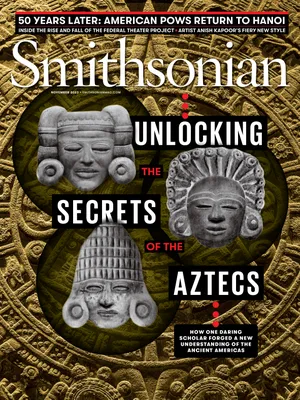When Hershey’s Crafted a Special Treat for the Troops
In the run-up to World War II, the chocolate company was tasked with creating a nutritious snack that, by design, wouldn’t taste good
:focal(2306x1735:2307x1736)/https://tf-cmsv2-smithsonianmag-media.s3.amazonaws.com/filer_public/c8/71/c871428f-6206-4a16-8f08-b2a2efc23b9d/2023_03_02_smithsonian_2169_final_copy.jpg)
When Captain Paul Logan of the United States Army Quartermaster General’s office started concocting the tactically smartest chocolate to give to U.S. soldiers during operations, he issued an unusual directive: Don’t make it too delicious.
It was 1935, still the Great Depression, and the military was working with a limited budget. As Logan collaborated with Hershey’s to create these rations, he was firm that the product should “taste a little better than a boiled potato.” Logan wanted a bar dense with the most essential nutrients, supplying carbohydrates, protein, fats and minerals to replenish troops in emergencies—but not so irresistible that the soldiers would eat any more than they needed. According to Frank A. Blazich Jr., a curator of military history at the Smithsonian National Museum of American History, Logan conducted up to 300 experiments, manipulating the ingredients many times over to find the right fusion. “He even tried kerosene at one point to deter palatability,” Blazich says. In 1937, Logan and Hershey’s settled on a mix of oat flour, skim milk powder, cocoa butter and chocolate liquor, but not a lot of sugar, leaving a dry, bitter aftertaste.
Besides an unpleasant taste, Logan had other stipulations for the chocolate: It had to weigh no more than four ounces, for portability in pockets; it needed to be a strong and efficient energy source; and it needed to remain solid at high temperatures so it wouldn’t melt and go to waste.
Hershey’s chief chemist Sam Hinkle tackled the job of producing this innovative candy (if something so bitter can be called candy). He devised a creation that was tantamount to a rock in texture and feel, and that soldiers would have to cut with a sharp knife, as it was almost impossible to bite into—and certainly not advisable, if you valued your teeth. The guide for eating the Ration D, as Hershey’s called it, suggested nibbling on the bar over the course of half an hour, or else letting it dissolve in water as a drink. Each bar delivered a valuable 600 calories or more to armed consumers, who were directed only to eat them as a last resort, to prevent starvation in extraordinary circumstances. Hinkle also modified the recipe to incorporate vitamin B1 in the form of thiamine hydrochloride—useful in tropical climates, where troops might be susceptible to vitamin deficiencies and associated diseases, like beriberi. Astonishingly, given how many ration bars Hershey’s produced, these wartime chocolates had to be molded by hand, as they were too dense and rich for the machines of the day to have any accuracy; Hershey’s equipment required partially melted chocolate, and Ration D did not melt at any reasonable temperature.
Pleased with Hinkle’s samples, Hershey’s churned out 90,000 bars between April and June 1937—all made by hand.
The outcome suited the quartermaster’s wishes and was tested in different environments from the Antarctic to the Philippines (though some soldiers found it inedible and refused to ingest the emergency ration during wartime). In one instance, Louis Zamperini, an Olympic distance runner turned Army Air Corps lieutenant, gave thanks for Ration D after his aircraft crashed over the Pacific in 1943, forcing him to drift on a lifeboat for 47 days with only a few chocolate bars and whatever fish he could procure at sea for sustenance. He was discovered and taken as a prisoner of war by the Japanese Navy for two years before his release, a story told in Laura Hillenbrand’s 2010 book, Unbroken: A World War II Story of Survival, Resilience and Redemption.
Over time, military commanders decided they wanted a more appetizing option. Consequently, the Army directed Hershey’s to remake the bar with a more appealing (but not too appealing) flavor. This need led to the creation in 1943 of the Hershey’s Tropical Chocolate Bar, which came in both one- and two-ounce blocks. While production of the Ration D came to an end shortly after the end of World War II, the Tropical Bar remained a staple in subsequent wars, fed astronauts on the Apollo 15 mission to the moon in the summer of 1971 and was doled out to soldiers until as late as 1991.
At the National Museum of American History, while visitors won’t get a taste of either chocolate bar, they can see an original wrapped Ration D bar with its bold-brown vintage lettering, an ode to a no-nonsense wartime snack that got the job done.
